Excerpts from
Daily Life in Ancient Egypt
A CooperToons Most Merry and Illustrated History
Unabridged Edition Available from Amazon
KindleTM Paperback
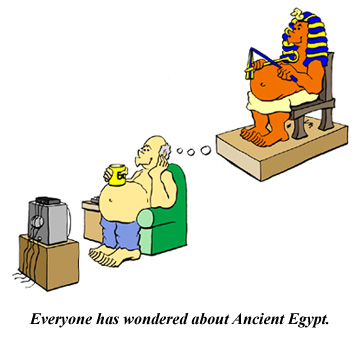
At one point or another, everyone - that's everyone - has wondered about Ancient Egypt. Even the most avid listeners of Howard Stern, rabid watchers of Spike TV, or fanatical listeners of WIP Sports Radio will occasionally set down the remote, lean back in their recliner, vent forth a hearty belch, and wonder what life was like in the time of the Pharaohs.
Ancient Egypt as we think of it lasted from about 3200 BC to maybe 343 BC. After that, the country was ruled by non-Egyptians ranging from Persians to Greeks to Romans to Kurds to Turks and finally to the British. It wasn't until 1952 (or arguably 1956) of our own era that native Egyptians were finally back in charge.
Of course, by then the old Egyptian culture was dead and gone. The last hieroglyphic inscription was written in 394 AD, and a cursive form was used until 425 AD. The last functional Egyptian temple was closed down around 535 AD. By then the Christian church was fully in charge of the former Roman Empire and didn't take kindly to any of the leftover heathenish cults. Certainly after the Islamic conquest you either worshiped as one of the people of the Book, or you didn't worship at all. So after about 640 AD you can say there were no more Ancient Egyptians.
The Best Place in the World
What strikes everyone about
Ancient Egypt is how different it was. It had the stiff
statues, kings with funny beards, writing that looked like pictures,
pyramids, and even a river that everyone wanted to flood. Yes,
Egypt was different.
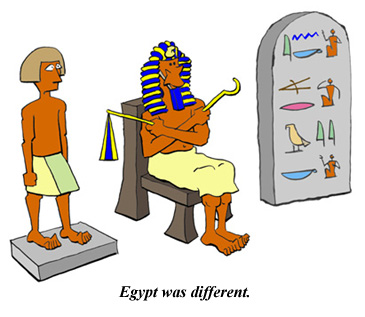
Naturally in these politically correct times it's become virtual blasphemy to say people are different. But Egypt had such a distinct climate and geography - for all practical purposes the country was only a few miles wide and it virtually never rains - that they had to be different. So yes, folks, it is OK to say the Egyptians were different.
The Greeks thought so. When the
historian Herodotus visited Egypt in 425 BC, he even said Egyptians
did everything backwards. We, he said, (that is, the Greeks) eat
indoors and the Egyptians eat outside. Our priests wear beards, he
said, and the Egyptian priests shave. He even claimed (and this is no
joke) that the women stood up to go to the bathroom and the men sat
down. We don't know how he knew that. Since he didn't know the
language, maybe he just blundered into the wrong door.

There are historians, though, who don't believe Herodotus at all. Some think he didn't even go to Egypt and spun his tales out of the whole cloth. But that's a rather harsh judgment. A bit more charitable attitude is he did go to Egypt and wrote down what he saw and was told as well as he could. But since he was told a lot of poppycock (like the Persians had thin skulls and Egyptians had thick ones), a lot of poppycock ended up in his book. But we still wonder about the bathroom bit.
But it was the Egyptians themselves who really thought they were different. It was a good difference, though. As far as they were concerned, Egypt was the best place in the world, and at the time they were right. For one thing, Egypt was one of the few countries that actually produced more, that's more, food than the people needed. There was water always at hand, and the climate was perfect, particularly for a bunch of people who didn't like wearing clothes.
Dress Like An Egyptian
Like any other country the
Egyptians' dress changed over the years. But the practical aspects of
having to weave cloth by hand on the simplest of hand looms kept
things pretty simple.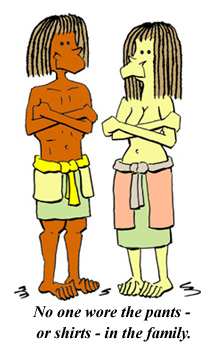
In Egypt, no one wore the pants in the family mainly because no one had any pants. Come to think of it, no one really had shirts either. In the earliest dynasties starting around 3200 BC and even in the days of the Old Kingdom, say 2500 to 2100 BC, most everyone just wrapped a piece of cloth around their waists and went about their business. If it got a bit cool you could toss a cloak, which was just another piece of cloth, over your shoulders. In the later years, there was some elaboration of the fashions, but even the finest duds stayed pretty rudimentary.
From looking at the statues and
paintings of the Egyptians, it's not always clear what kept their
clothes up. Excavations have found some kilts (as the basic garment
is commonly called) were held in place with a kind of drawstring.
Other times it was just a strip of cloth that served the purpose of a
belt and was tied in the front. For the ladies, sometimes it was just
a tight fit that did the trick.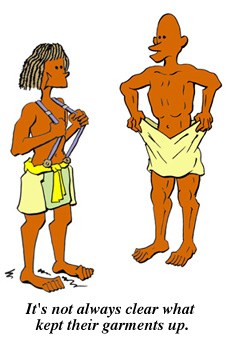
The ladies' clothes have been the subject of some debate because it's not really clear how literally we should take the artistic representations. A lot of tomb paintings show the garments clinging so tightly that everything - and that means everything - stood out in high relief. Other dresses seem more diaphanous and loose, but if the pictures are to be believed, the ladies that had it liked to flaunt it.
One style of dress was a kind of a strapless gown with a vengeance. You might think of it as a backless dress with a décolleté to just above the navel. Other times there were straps which gave the outfit a more or less conventional cut. Things are a bit confusing because paintings and statues don't really agree on how the various parts were arranged.
When the dress had two straps, the statues usually show the straps going from just above the midriff and over the shoulders with a modesty that fits today's conventions pretty well. At other times, though, there's only one strap which covered up only one of the critical pair. Such a design, men are told, would be a bit uncomfortable, or at least feel kind of weird.
Now here's where the dilemma comes in. Some authors point out that in tomb paintings the single strap version is not shown properly. Instead you see a slight shift in the strap (or in the body part) that might be fine at Super Bowl half time, but would be frowned on at your nephew's baptism. One conclusion is that the tomb paintings were obviously drawn by men and are not to be taken too literally.
However if you do a careful review of various sources (if you get your jollies from doing that kind of stuff) you can uncover (no joke intended) at least one statue that shows the tomb paintings probably are not simply idealistic renderings of randy workmen. Around 1950 B. C., a nobleman named Meketra had some wooden carvings commissioned to go into his tomb. They were found in the 1920's and are some of the nicest depictions we have of scenes from everyday Egyptian life. There were a lot of ladies in the models and what you have is 1) two straps covering everything, 2) one strap covering only half of everything, and 3) no straps at all, covering nothing of everything. We repeat, that's most of the ladies.
But (and there's always a but) there is at least one figure that shows a lady working in a brewery. Here there is a single strap which goes up over the shoulder. To borrow a modern Madison Avenue phrase, it separates, but sure as heck doesn't lift. So although the single strap double revealing model might not have been typical, it apparently did have a vogue with at least some of the ladies.
The cloth most used was not cotton - raised abundantly in Egypt today - but linen from the flax plant. The weave could be quite fine and once more the artists (i. e., men) depict the ladies' clothes to be so thin as to be veritably see-through. Again it's not clear how literally we should take the renditions. At the least, though, it seems that the dresses were thin enough so the ladies could show off their generally shapely figures which (as in Egypt today) tended to be on the slender side.
One inescapable conclusion we can draw from the fashions, statues, and tomb paintings is that the Egyptians did not have the same sense of modesty that we do. When working the Egyptian women might wear clothes that weren't all that different from the men. Today such apparel might strike us as a bit titillating (no pun intended), but there's no indication that the men thought anything about it.
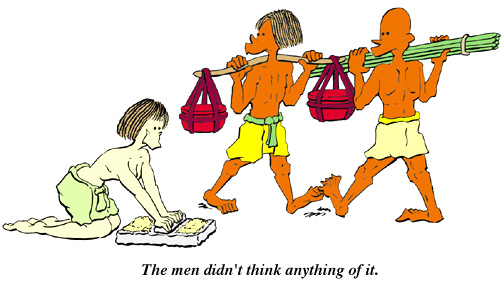
Men in Egypt liked to get decked out in their finery, as much, if not more, than the women. But of course when all you had was a strip of cloth to wear there wasn't much to deck. The gentleman's solution was to starch his loincloth. This was the Egyptian equivalent of the three piece suit, and the front part then stuck out - quite literally - a foot or more. The purpose, we are told, of such a clumsy garment was to show the wearer didn't have to do manual labor. Or maybe it was just a gentleman's way to let the girls know he was happy to see them.
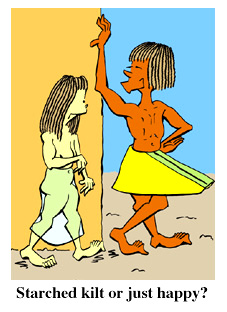
Children, on the other hand, usually wore nothing at all. So none of the kids ever had to hear their folks gripe that they couldn't play outside or they'd get their clothes dirty. No matter how much they got covered with the thick Nile mud, a quick rinse and a rub with vegetable oil (Egyptians didn't have soap) would put things right. Sure, the kids might be a bit slippery, but all in all it made for a simpler life. At the very least, the kids didn't ruin their clothes since we can be sure that then as now kids tended to slop their food when eating.
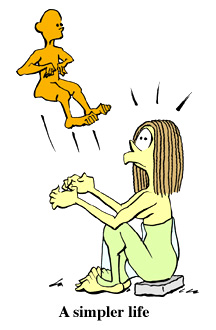
Eat Like An Egyptian
One thing that set Egypt apart from other ancient nations was that in normal times pretty much everyone had enough to eat. It was one of the first countries to regularly produce bumper crops of wheat, and it was Egyptian grain that eventually provided the free bread for the Romans' bread and circus culture.
Oddly enough, it was the abundant bread that caused the Egyptians to have problems with their teeth. But like other people in many ancient cultures, they did not have much tooth decay in the modern sense. It wasn't until the after the fall of Rome and the advent of the Middle Ages that sugar became common enough so enamel-eating bacterial found a happy environment to make rotten teeth a charming characteristic of the early European (and later American) smile. But Egyptians had a very unsugary diet. So why did they have such problems with their choppers?
The Egyptians may not have had
sugar, but they had one ingredient that was even worse - sand.
Nowadays stoneground flour is milled in a way the stones don't come
into direct contact, and so the stone itself doesn't wear away and
get into the flour. The Egyptians, though, made flour by hand by just
rubbing the grain between two stones. The abrasion of stone on stone
produced grit that ended up in the bread. Also a lot of work was done
outdoors, and sand simply blew into the grain.

So when the Egyptians ate their bread they continually wore down their teeth. It didn't take too many years before the enamel could get worn through. We have mummies with teeth literally worn down to the gumline.
The problems Egyptians had with their teeth was not just the annoyance of having to gum their food. Once your teeth get worn down, abscesses and bacterial infections set in. In pre-antibiotics days (which included the first half of the twentieth century), even minor infections could literally do you in. The mummy of Ramses II (that is, Ramses the Great) had a jaw infection that was so severe it may have been what killed him. So the Egyptian bread had the double characteristic of being what kept them alive and healthy and yet was definitely hazardous to their health.
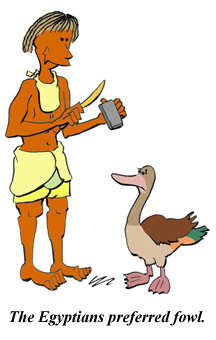
There were, though, some people - even relatively senior citizens - who had healthy, almost perfect teeth (the Pharaoh Seti I, Ramses's dad, was one). The natural conclusion is these people didn't eat much bread. That might even have been true. The Egyptian diet was, in fact, quite varied and except for the sand in the bread, quite healthy. They had fruits like dates, raisins, and pomegranates. For vegetables they had beans, peas, lentils, leeks, onions (reputed to make people randy), lettuce, and garlic. They also had milk and so must have had some dairy or cheese products. Certainly if the Egyptians wanted to eat a proper diet, they could.
Although dietitians will tell you meat was a rarity before our own time, Egyptians probably enjoyed more meat than other ancient people (and by "meat" we also mean fish and birds). After all, just a short walk to the Nile brought you to relatively easy fishing, and game birds flocked to what was the only real source of fresh water. In fact, it very well may have been less time consuming to catch and fry a good catch or snare a bird than in harvesting, threshing, and grinding grain. The availability of the types of meat also affected the Egyptians' taste buds, and all in all they preferred the fowl and fish to other meat. But they did have and would also eat beef, mutton, and even pork.
Drink Like An Egyptian
As far as drink, beer was the hands-down favorite, largely because it's what they had. True there were various types of highly prized native wines, but grape growing was pretty much restricted to the gentlemen farmers in the Delta, and wine was expensive. So drinks made from grain were the ones most available for the average citizen.
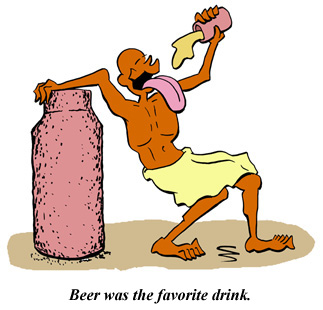
It has been said that there was no distinction between an Egyptian brewer and a baker. In the older books we even read they made their beer simply by crumbling partly baked and risen bred into water and letting it ferment. Nowadays, though, scientists have looked at the beer residues, and the tendency is to think the beer was made more like the modern process. Perhaps, but at the same time we have the small wooden mock-up of a brewery from Meketra's tomb, and it clearly shows ladies making little bread cakes. So maybe we shouldn't toss out traditional wisdom, particularly since there's no reason to think all beer was brewed in just one way.
We do know Egyptians brewed beer with both barley and emmer wheat. If they used the modern technique, they spread out the grain (probably on the floor) and let it sprout (called malting by modern brewers). Possibly only part of the malted grain was roasted. You could then pound the roasted and unroasted, malted and unmalted grain with wooden poles, and you put them in a crock with water. Finally you tossed in the yeast which was either from a dough starter or just taken from a recently emptied fermentation jar.
We don't know how or if alcohol content was deliberately varied. Egyptians didn't have sugar per se, but they did have honey and dates, both which could have been added to the beer to up its punch. But modern analysis casts doubt about such additives. In any case after the stuff set for a while it was ready to drink.
There are texts which make it sound like beer was brewed on one day and drank in a day or two. That may have been an exaggeration, but it is possible that some beers did not sit too long before drinking. This wouldn't been that different from some other Middle Eastern beverages. Although drinking wine (khamr) is forbidden in Islam, the fatwahs did allow a drink made by mashing up dates and letting the juice sit for three days. What you got was nabith, a sweet tasting and mildly fermented beverage that was even favored by Muhammad. Even today the low alcohol content of nabith is still a marker for Islamic authorities who determine what is and is not forbidden among observant Muslims.
But whenever it was ready, beer probably wasn't kept too long before drinking. If storage was needed, it could be kept in clay-stoppered jars. We don't know how tight the jars were. If the stoppers could contain the carbon dioxide arising from secondary fermentation, then when the Egyptians popped a stopper they could have a foaming beverage not all that different from our own. On the other hand, if they let everything ferment before stoppering or if the bottling wasn't that tight, they would have had a flatter tasting brew similar to the "draught" beer of the nineteenth century. To get a hint of what that would taste like, let an open bottle of beer or sparkling wine sit for a day or so and then try a swig. Bleah.
Alcohol was then definitely a part of the Egyptian diet. It was a daily staple to be sure, but as today, everyone also drank when they got together for a party.
Party Like An Egyptian
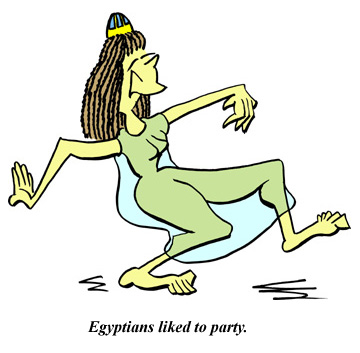
It's amazing how fast the advent of electronic entertainment - radio, television, and video games - has made people forget that for the first 5000 years of civilization, the only real mode of entertainment was to party. Now that doesn't mean you had to go on a full scale blowout. Instead, to enjoy yourself you got together with some people of like mentality for some common form of entertainment. It might be at a home, a restaurant, a sports event, or maybe at a theater. You could talk, play games, sing songs, but what you didn't do was plop yourself down in front of the tube with a bag of chips, a remote, and a couple of six packs of beer, Egyptian or otherwise.
The Egyptians liked to party and as for partygoers everywhere, part of the fun was to have a plenty to eat and drink. Although they had their proverbs warning against overindulgence, they paid no more attention to the rules than anyone else. There are tomb paintings of people whooping it up at banquets and parties, even going so far as to show delicate ladies heaving up their drinks.
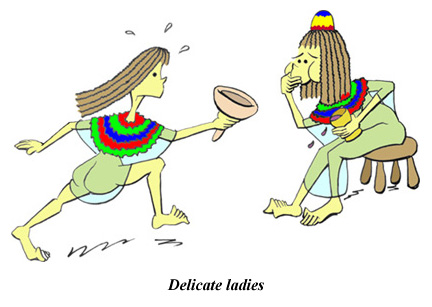
At the fancier get-togethers, there were usually musicians and dancers to entertain the guests. The latter were inevitably sweet young things, some of whom would also perform back bending acrobatics in attire that was skimpy even for the Egyptians (which makes you think the entertainment was organized by the men). But unlike the symposia in Ancient Greece, both men and women could attend. The ladies might gather on one side of the room to chat, gossip, and smell lotus blossoms, but the husbands and wives did often sit together which we can be sure didn't always make for a harmonious night once they got home.

Of course, life in Egypt wasn't all getting gussied up, eating, drinking and partying. Much of the day was just doing your jobs, whatever it happened to be. After all, in Egypt everyone had to make a living since then as now they had to contend with both death and taxes.
The Government
Egypt was the first unified country in the history of the world. Except for a couple of dark ages (called "Intermediate Periods" by historians), it lasted as an independent and united country for nearly 3000 years.
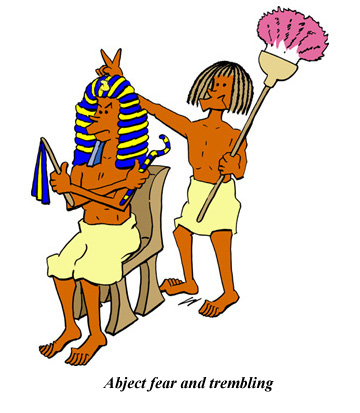
The head of the government, as everyone knows, was the Pharaoh. Not only was he the king, we're told, but he was also a God-On-Earth. All his subjects worshipped him with abject fear and trembling.
Well, maybe. We also have what might be considered the Egyptian version of the mustache on the campaign poster. An inscription on a block from the pyramids reverentially proclaims "How drunk is the king!", and in one tomb we've found a rather explicit drawing which is usually interpreted as the female Pharaoh Hatshepsut making whoopee with her chief advisor Senmut. Evidently some of the Pharaohs didn't seem to take their lofty positions too seriously either, one somewhat laconically stating "Royalty is a good profession".
Whether he believed he was divine or not, no Pharaoh, though, was a hands-on ruler. He couldn't be, particularly if he was one of the warrior-kings like Tuthmosis III or Ramses the Great who spent a lot of their time out of the country fighting battles.
The Pharaohs all had a top assistant who was essentially a prime minister. Today he is usually called by the Middle Eastern term, vizier, although this is something of an anachronism.
In any case, if the Pharaoh was out fighting, then the vizier was left running the country. If the Pharaoh was at his palace lolling about with his concubines, then the vizier was the one left running the country. Come to think of it, if the Pharaoh was sitting around scratching his rear end, then the vizier was the one left running the country.
The vizier couldn't do everything himself either, and there were subordinates all the way down to the local level. Egypt, like most large countries, was divided into geographic subdivisions. Today these are usually referred to by their Greek name, nomes. Each nome was headed by an official called a nomarch, who was the equivalent of a governor of the state. Physically the nomes were not particularly large, and there were around about twenty or so lining up and down the Nile proper and about the same number in the delta.
The governors, like all officials in Egypt, were appointed (Egyptians didn't have to worry about voting, as they say, early and often). It was also the governors who ultimately had responsibility to collect the taxes. So a visit from the nomarch was not necessarily looked for by the citizens, although the actual collecting was more often handled by the mayors and the local or regional tax collectors.
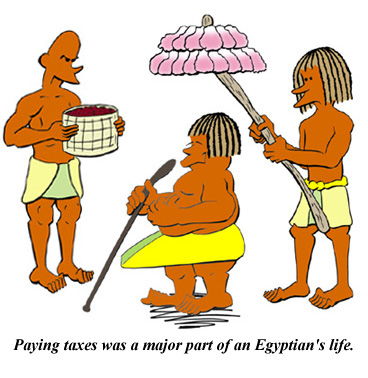
Paying taxes was a major part of an Egyptian's life. You read that this was complicated by the fact Egypt had no currency, and that everything was barter. True, they did not have money in our sense, but there was an exchange rate based on the deben, which was a unit of weight. Different authors give different weights for a deben, but the range seems to have been between 90 and 94 grams, with 91 grams being the median. A deben, then, was about three and a quarter ounces or a bit under a fifth of a pound. So while it is true that there were no minted coins in Egypt until the Greeks came in, you could exchange goods and services for a given number of deben of gold or silver or copper. The rates of exchange varied but in the heyday of the New Kingdom one deben of silver was worth 100 deben of copper.
Payment of debts, whether taxes or otherwise, were still often paid in goods, a practice that continued well into our own nineteenth century. A farmer would pay in produce, a fisherman in fish, and artists and craftsman might devote part of their year to working on projects of the state. In Egypt, there were lots of those projects. That's how the pyramids got built.
Building the Pyramids
There's one thing everyone
knows about Egypt, and that's where the pyramids are. Despite what
the average Joe Blow may think, there are more than the three
pyramids of Giza. There's actually close to a hundred of them
scattered about the land, some small, some big; some finished, some
incomplete; some impressive, and some absolute fiascoes of
construction.
First we'll clear the air about how they were built and admit that some details of construction are not known. And yes, it's also true that there were very likely special techniques and tricks that the Egyptians used that we haven't figured out. But it didn't take aliens from outer space who used amazing, almost miraculous machines that vanished from the archeological record leaving only stone and hand tools.
The real key to their construction was the way the Egyptians worked stone. We know from tomb paintings they had basic techniques capable of making hollowed out vases of granite or dolomite (a stone harder than granite). Once more the trick was the basic commodity they had plenty of - sand. The sand was added to the place they were drilling or cutting and acted as an abrasive. That was the trick for cutting stone even when the Greeks and the Romans used iron tools. The Roman historian Pliny the Elder specifically mentions using sand in cutting marble. He said flat out that it was the sand that cut the stone - not the iron. So there's no secret here.
Tests have shown that a novice to the Egyptian method can drill an 11 inch core in hard stone in about 5 hours. The guy who did that thought a skilled craftsman could do it in about half that time. So if you can drill a one foot core into granite or dolomite in less than 3 hours, you should be able to drill a one foot core in limestone in about one. Boring a four foot hole through limestone, then, should easily be done in less than a day.
All right. So you have a gang of about five guys drilling holes in a limestone quarry. After four to six hours they've gotten holes drilled deep enough to define a block a few feet on a side. Then they pack the holes with bits of porous wood. They pour water into the holes and in the equivalent of ancient blasting, the wood expands so fast that the block splits out with a bang (or at least a crack). The need to smooth the blocks could be lessened if you put the blocks in the pyramid just as they came out of the quarry. That way they would fit snug against each other and insure such a tight fit that people four thousand years in the future would say it couldn't be done without aliens from outer space.
But you still wonder. Even with all the tricks, were the pyramids too big a task for a so-called primitive culture? The sheer number of blocks is staggering and has led some people to say the only way they could have been built was to have a super-civilization using amazing machines the likes of which we don't have and don't know how to build.
Well, folks, let's try a little elementary math. You got five guys in a team knocking out a block of stone a day. We'll give them fifteen out of Cheop's twenty-three years as king. And for a first approximation we'll say the workers were at the construction site for less than half a year or 180 days. The rest of the year they had to go back to the farm.
We now have 180 blocks of stone turned out per five man crew per year. That's 36 blocks per man. In fifteen years we have 540 blocks per man. 5000 men working at any given time would give us 2,700,000 blocks of limestone. The estimated number of blocks in the largest pyramid is about 2,500,000.
If our guesses are off? Well, then say it took the crew two days per block. Then 10,000 men could do the job in 180 days. Or 7500 men worked 270 days. Say they worked only three months of the year. Then the block a day quota would take 10,000 men. All reasonable scenarios for the manpower and technology of the time.
So in the end, building the pyramids was impressive, yes, but it didn't take a hundred thousand slaves working together like the guides told Herodotus and you see in the movies. Inevitably the pictures show a gang of several hundred slaves under the overseer's lash hauling blocks - which was usually the size of a house - over rollers along the road. At some point some poor sucker would trip and get mashed - either that or saved by the hero.
Actually in Ancient Egypt the institution of slavery wasn't all that advanced (if you want to call it that). People would be in the service of others (no wisecracks, farmboys), yes, and certainly prisoners of war were held in servitude. But it's unclear whether statutory chattel slavery in the Greco-Roman or ante-bellum American sense really existed.
A first hand example of the difference of Egyptian slavery from other later developments comes from when the Persians ruled the county. One of the guards on the island of Elephantine wrote a bunch of letters over the course of twenty or so years. They deal with his family and in one case he bought a slave. What is interesting is that from the letters we know that the girl was treated as a family member and was accepted as an adopted daughter. She eventually married a free Egyptian man. The fact that the family was Jewish doesn't seem important and there is nothing in the letters that make them seem that their neighbors looked one them as anything except a perfeclty normal Egyptian family.
Instead most historians believe the builders of the pyramids and the tombs of the Pharaohs were free men hired by the state, some of them highly skilled workman and artists. From graffiti on the stones themselves, we know they were organized into crews, some at least which had considerable espirit de corps. The blocks, too, were of good size, but most were about waist or chest high. The typical construction blocks weighed maybe 2 to 4 tons.
Again impressive, yes, but not miraculous. Certainly the Egyptians knew how to make corners at 90 degrees, lay out accurate distances, and how to make a flat foundation. We have some of their actual plumb bobs and for the massive layout of the pyramids the simplest method would be to dig trenches around the area and fill them with water. The water level would define a level plane. The main error would be when the wind would shift the water a bit. In fact, the so-called deviation from true is what you expect based the average force of the prevailing wind.
And moving the stones? Actually that was the easy part. Instead of using slave-crunching rollers, the Egyptians moved huge - and we mean huge loads - using a neat trick that would never have occurred to us if we hadn't seen it in tomb paintings. The load would be put on a sledge, and a mud track was laid down. You then dragged whatever you were dragging along the track, pouring water in front of the sledge as you went along. Tests have shown that only one man - yes, that's only one man - can easily pull a one ton stone along a such a track. So you only needed two to three guys to pull the typical blocks used to build the pyramids.
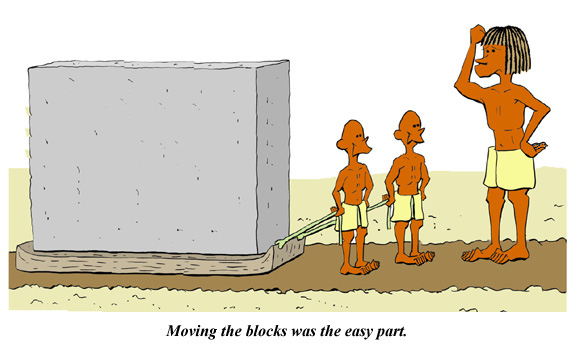
From the movies you'd think the blocks had to be hauled miles to get to the construction site. Again, not true. The limestone blocks were from bedrock that was literally right next to the pyramid itself. So you had to haul the blocks only a spitting distance to put them in place. Only the outer surface and parts of the interior rooms were granite, and these did come from the quarries at Aswan.
You'd think the really tough part must have been getting the stones up to the top. But maybe not. Herodotus, our chatty Greek tourist, said the Egyptians used "machines" to do the job. But the Antikythera Mechanism notwithstanding, when Greeks talked about a machine they didn't necessarily mean a complicated contraption with wheels, gears, and pulleys in our modern sense. Some Egyptologist speculate the "machines" were no more than a larger variation of the well-known shaduf that even today is used to lift water from the Nile to the fields. But it turns out there's an easier way that wouldn't have taken many more men than needed for hauling the block over the ground. And that did involve a machine - a simple machine - the inclined plane.
What you do is have staged ramps. When a block got to the base of the ramp, or to one of the flat stages, you pull the rope on the sledge up the ramp and tossed it down to a group of guys on the ground. Then with feet firmly implanted on Mother Earth (or on a lower ledge), they would pull on the rope, hauling the block up the ramp. The footing there would be much firmer than for a crew actually on a mud-slicked incline, and for a 10 degree slope, 25 guys would have to heave only about 35 pounds each to get the 2.5 ton block up the incline. It takes some effort yes, but not superhumans.
The ramps could have been simple inclines leading directly up to the particular level on the pyramid or they could have looped around the side. The latter arrangement would have been easier to have the flat staging areas. The reason not too many remnants of construction ramps have been found (but some have) is that they were made of unbaked mud brick which isn't as permanent as stone. And besides, they're not there anymore because the Egyptians tore them down when they were done. Then getting rid of the bricks was easy. You just dumped them into the Nile, which was definitely a nice thing to have around.
The Nile
Every book or article on Egypt somewhere quotes Herodotus saying "Egypt is a gift of the Nile" and this history will be no different. The statement is pithy, catchy, and when you get down to it, pretty obvious.

Actually what Herodotus said wasn't quite so succinct. What he wrote was, "For any one who sees Egypt, without having heard a word about it before, must perceive, if he has only common powers of observation, that the Egypt to which the Greeks go in their ships is an acquired country, the gift of the river." A bit more long winded.
The Nile had a particular quirk that was both a boon and a bane. Every year the snow on the mountains in the African interior melted and ran into the inland rivers and lakes that fed into the Nile. Herodotus himself heard the story but thought it was a bit far-fetched. The net effect in any case was every year the Nile would flood, covering most of the land. The time of the flooding was so regular that one of Egypt's three seasons was called "Inundation".
Inundation lasted from June until October. When the waters receded, the land was covered with the thick black mud, rich in nutrients. Since the land was now wet and soft, planting was easy, and in normal years, bumper crops were typical. Of course, at times there was too much water and towns got washed away. Then if there wasn't enough water, you had famine. The seven fat years and seven lean years in the story of Joseph show what happened when the Nile didn't do what you wanted.
At 4180 miles, the Nile is the longest river in the world - provided you define a river so other rivers aren't longer. The Amazon officially is 3977 miles long, but if you include a tributary that is technically not hydrologically part of the main river, it beats the Nile by a few miles.
Another contender - a surprise to many - is the Missouri-Mississippi system in the United States. The combined length is 4661 miles. That may seem like cheating - that is, combining two rivers into one - but since the size of the Nile is a combination of the Blue Nile, White Nile, and the Nile itself, there's no reason not to link the Missouri and Mississippi together.
So why didn't a major civilization spring to life along the Mississippi and Missouri? Well, it did. But the problem is white Europeans and their descendants made sure they defined civilization so the American "savages" could be thought of as, well, savages. But the Native American tribes along the river (and elsewhere in America) were in fact a civilization - they had towns, trade routes, laws, courts, and even taxes (yes, they paid taxes).
Why then don't we think of the early American Indians as a civilization? You can't say it was because they didn't have a central government (neither did the Greeks) or that the villages were too small (some early Canaanite "kings" only ruled over maybe 200 to 300 people). We'll even pass over the fact that if you don't consider people a civilization, you don't feel bad when you take their land. But what really made "savages" out of the American Indians was simply that they didn't have a written language. That the Egyptians definitely had and virtually from the start.
The Hieroglyphics
The hieroglyphics are
probably what most people think of as the most unique characteristic
of the Egyptian civilization. Whether you're in Cairo, Egypt or Lake
Lotawana, Missouri, just show anyone a photograph of hieroglyphics
and they'll immediately (and correctly) label it Egyptian (well, that
may be overly optimistic if you're in Lake Lotawana).
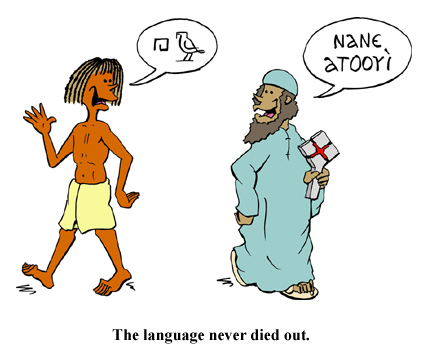
First we'll clear the air with any professional Egyptologists who have so much time on their hands they're wasting their time reading this. Yes, the real word for the pictures is "hieroglyphs" not "hieroglyphics". And we know if you want to use the latter word you have to say something like "hieroglyphic writing". But here we'll follow colloquial usage and accept hieroglyphs and hieroglyphics as interchangeable. To all true scholars we humbly apologize for such a cavalier attitude by saying, well, that's just tough tiddy.
Although it is assumed that Egyptian hieroglyphics started out as simple picture writing, the first real examples we have are of a full blown phonetic and alphabetic script. But the Egyptians added some complications that confused people for a couple of thousand of years.
People naturally wonder how you can read a language that hadn't been used for two thousand years and had completely died out. The truth is you can't, and it didn't. In fact, Ancient Egyptian never died out and is still used today.
After the fall of the native pharaohs and the conquest of Egypt by the Greeks, the residents eventually began to see the advantages of the Greek alphabet. Borrowing most of the letters and keeping some characters derived from cursive hieroglyphs, they began to use this hybrid, but largely Greek, alphabet, now dubbed the Coptic script.
For various reasons, when Christian missionaries came to Egypt early on (tradition is Mark himself made the trip) they found Egyptians very receptive to the new religion. Although it seems surprising that people who worshipped gods with animal heads liked Christianity, it really isn't. There are a lot of parallels in Egyptian theology and Christianity and so the new religion seemed to fit right in. So when the Roman Empire adopted Christianity as its official religion, the Christian community in Egypt had a leg up on the remaining pagans.
The Egyptian Christians wrote their Bibles, not in Greek and not in Latin. Instead they wrote in Egyptian, but using Coptic, their sort-of Greek alphabet. Then when Islam conquered Egypt, in accordance with the teachings of Muhammad, they allowed Christians freedom of worship (provided they pay a tax). Today, the Coptic Christians are still going strong and have spread around the world (they even have a church in Des Moines, for crying out loud). And they have Bibles which are written in what is the last stage of the Ancient Egyptian language.
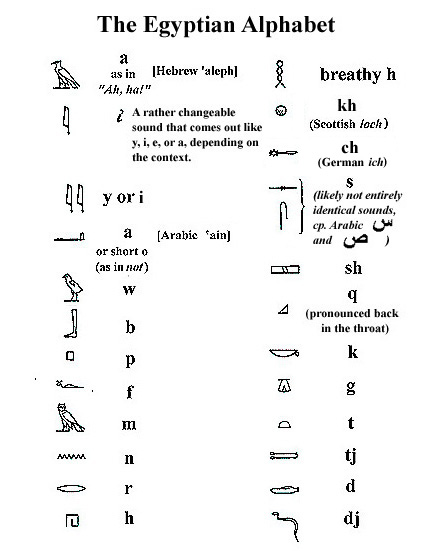
But by the Middle Ages, people had forgotten the connection with hieroglyphics and Coptic and it wasn't until the Enlightenment that serious study began on cracking the hieroglyphics. Probably the first guy to make real progress was Thomas Young, the discoverer of the wave theory of light. By comparing a number of Egyptian writings with Greek equivalents, he worked out the characters for the names of a number of the pharaohs and queens from the Greek period.
Then Jean François Champollion, a young professor of languages at Grenoble, also had compared the Greek writing of the Rosetta stone with the hieroglyphics and from looking at hieroglyphic versions of other Greek and Roman names figured out the sounds of more of the characters. In 1822, he wrote a famous letter to the secretary of the French Academie des Inscriptions and that's the year historians officially use to mark the decipherment of hieroglyphics. Champollion also had a firm knowledge of Coptic and began to recognize the meaning of ordinary words. The connection was made and within a decade or so, people were again reading actual Egyptian texts.
What Champollion and his friends found was that every Egyptian word can be spelled with one of twenty-five basic characters (some linguists make it twenty-three or twenty four), each of which can be represented by a picture. For instance, a leg is "b", and an owl is "m". As a concession to English speakers some of the letters - the vulture, the reed, and the baby quail - are sometimes written as vowels. But all the characters are really consonants.
In Egyptian, then, words were
formed from letters by the sound regardless of what the
pictures meant. Look up the letters for dj and d -
which are the snake,![]() , and the hand,
, and the hand,![]() .
Put them together and you have the Egyptian word for "say",
djd,
.
Put them together and you have the Egyptian word for "say",
djd, ![]() .
So the word has nothing to do with either a snake or a hand - that
is, unless the person talking is a heavy-handed
snake-in-the-grass.
.
So the word has nothing to do with either a snake or a hand - that
is, unless the person talking is a heavy-handed
snake-in-the-grass.
Now if the Egyptians had simply
stuck to their alphabet, then linguists probably would have figured
things out much earlier. What threw people off was that in addition
to twenty-five letters, there were also about seven hundred
other characters that stood for for two and three letter
combinations. So rather than write the word "beautiful", which was
nfr, with the separate consonants, ![]() (n),
(n), ![]() (f), and
(f), and ![]() (r), they preferred to use only one symbol,
(r), they preferred to use only one symbol, ![]() , for all three written at once.
, for all three written at once.
All right. But if the sound was paramount, then the picture of something also represented its sound. So surely there was picture writing where the sound and the picture were the same.
Well, yes and no. For instance,
the word for heart was something like ib (or ab), and yes, it
is written as a picture of the heart, ![]() .
But still it was the idea of sound that came first. More often
you had a picture that had nothing to do with the meaning. For
instance the word for "son" - a male child - was sa. But since
the same two letters also meant "duck",
.
But still it was the idea of sound that came first. More often
you had a picture that had nothing to do with the meaning. For
instance the word for "son" - a male child - was sa. But since
the same two letters also meant "duck", ![]() ,
the Egyptians used the duck picture for both words. Eventually the
picture of the duck came to mean "son" in almost all cases. So when
you wrote the Pharaoh was the "Son of Ra" (ergo, the Egyptian God,
Ra) you wrote this as,
,
the Egyptians used the duck picture for both words. Eventually the
picture of the duck came to mean "son" in almost all cases. So when
you wrote the Pharaoh was the "Son of Ra" (ergo, the Egyptian God,
Ra) you wrote this as, ![]() ,
and no one thought they were calling the Pharaoh, the "Duck of Ra".
That is, unless it was an inside joke.
,
and no one thought they were calling the Pharaoh, the "Duck of Ra".
That is, unless it was an inside joke.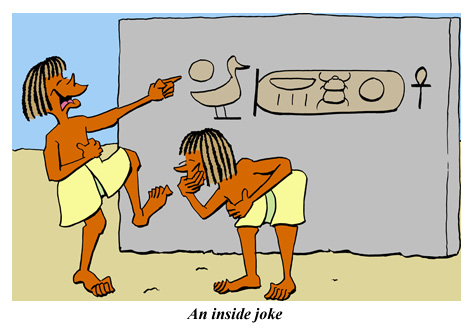
So the Egyptians had words that were spelled or sounded the same or had multiple meanings. But English is no different. For instance, "ass" can be either a donkey or your boss or the part of your body your boss rides as if it were a donkey. But since Egyptians didn't write the vowels they had even more words spelled the same than we do.
Lack of vowels really is no different than other familiar Middle Eastern languages. Arabic and Hebrew don't normally write vowels, although both these languages now have ways of cheating. Hebrew for instance can write little dots under the consonants to show the vowels. This is mostly an educational tool and is called "pointing" in Hebrew grammars. But Egyptians never developed a similar pointing system. No one knows why. Maybe they just thought it wasn't polite to point.
What the Egyptians did - like
the Chinese do now - was to add what they called "determinatives". A
determinative was a picture put after the word that helped indicate
what the word meant. For instance, the word for "kiss" (which also
meant "smell") was sn or ![]() .
If you look at the alphabet, you can recognize the s and
n characters. What looks like an arrow pointing down is called
a biliteral sign, and in this case it represents s and
n put together. This redundancy of letters with bi- or
triliteral signs is pretty characteristic of Egyptian writing and
.
If you look at the alphabet, you can recognize the s and
n characters. What looks like an arrow pointing down is called
a biliteral sign, and in this case it represents s and
n put together. This redundancy of letters with bi- or
triliteral signs is pretty characteristic of Egyptian writing and
![]() meant sn, not ssnn.
meant sn, not ssnn.
But to make sure you didn't
confuse this with a similar word, the Egyptians stuck a picture of a
nose after it. So the full writing was ![]() . This seems simple enough. But it does make you wonder when young
Egyptian swains said good night to their sweeties they tried to steal
a good night sniff.
. This seems simple enough. But it does make you wonder when young
Egyptian swains said good night to their sweeties they tried to steal
a good night sniff.
Plurals were rendered by adding
a w at the end. A good example is the word "buttocks",
khpdw, and spelled, ![]() .
The determinative is there - it's the little comma looking thing
although it certainly doesn't look too much like a rear end. We know
this is a plural form, not only from the w at the end, but
from three dashes, which also indicated a plural. The Egyptians also
had a dual ending and so it's hard to figure why this word was
plural, not dual. Certainly from the art and sculpture, we're pretty
sure that Ancient Egyptians only had two cheeks like everyone
else.
.
The determinative is there - it's the little comma looking thing
although it certainly doesn't look too much like a rear end. We know
this is a plural form, not only from the w at the end, but
from three dashes, which also indicated a plural. The Egyptians also
had a dual ending and so it's hard to figure why this word was
plural, not dual. Certainly from the art and sculpture, we're pretty
sure that Ancient Egyptians only had two cheeks like everyone
else.
As in every language there were
exceptions to the rules of spelling and grammar. The word for "king"
is usually rendered as nsw but if you read it as written,
![]() , it comes out sort of like swtn (the guy with the beard is
the determinative). The linguists say this is because it was
originally a longer word and got shortened. The Egyptians, being a
conservative lot, didn't bother to change the
spelling.
, it comes out sort of like swtn (the guy with the beard is
the determinative). The linguists say this is because it was
originally a longer word and got shortened. The Egyptians, being a
conservative lot, didn't bother to change the
spelling.
Egyptian grammar had everything
we have in English: verbs, adjectives, pronouns, and complicated
rules that were probably ignored. For instance if you wanted to show
something was yours by adding "my", then you added a picture of a
person, ![]() ,
if you were a guy, and
,
if you were a guy, and ![]() if you were a gal. But you'd put it after the word as a
suffix. Again this is like Arabic and Hebrew and as in those two
languages, this ending was probably pronounced something like the
continental i ( ee in English). So if a man wanted to
refer to his particular buttocks he'd write
if you were a gal. But you'd put it after the word as a
suffix. Again this is like Arabic and Hebrew and as in those two
languages, this ending was probably pronounced something like the
continental i ( ee in English). So if a man wanted to
refer to his particular buttocks he'd write  for khpdw-i.
for khpdw-i.
Actually, lack of vowels could
make things a bit easier for the scribe since if there was a change
in the vowels of the word (like feet vs. foot) you
sometimes didn't have to worry about writing the word any
differently. A common form of the
verb in simple inscriptions is called the "exhortative" and it
indicates you want something to happen. So "May the king live!",
ankh nsw, was written ![]() .
Here the verb,
.
Here the verb,![]() ,
ankh, "May he live!" is written exactly like the infinitive
"to live" although it probably had an added or otherwise changed
vowels from the root form.
,
ankh, "May he live!" is written exactly like the infinitive
"to live" although it probably had an added or otherwise changed
vowels from the root form.
One last thing. It is not incorrect to write Egyptian hieroglyphics from left to right like you see in the textbooks and we're doing here. But it was not the normal way. Again as in Hebrew and Arabic, the Egyptians usually wrote from right to left. On a papyrus and especially when using the short hand versions of hieroglyphics called hieratic and demotic, right to left was correct. When writing hieroglyphics on tombs and in their temples, though, you could write both directions and even from top to bottom if it would look better. But in any case, the reader now knows enough Egyptian to write at least one useful sentence.
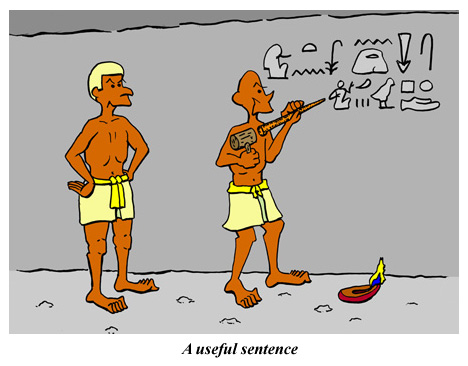
About Mummies
WARNING: THIS SECTION CONTAINS EXPLICIT DETAILS OF EGYPTIAN MUMMIFICATION AND IS PRETTY GROSS AND SO SHOULD BE AVOIDED BY YOUNG CHILDREN, DAINTY WOMEN, AND DELICATE MEN.
There's pharaohs, the Nile, and
hieroglyphics. We haven't forgotten the mummies.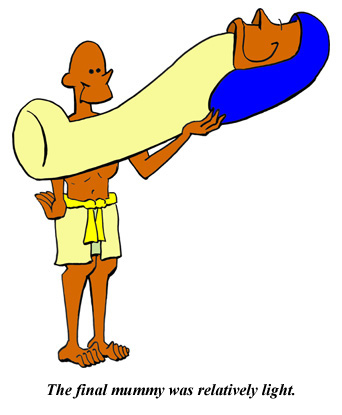
Most people who've read about Ancient Egypt know that mummification is not a "lost art" or one of the "secrets of the ancients". The basics of mummification were never lost. Herodotus wrote about it with reasonable accuracy (supporting the claim that he did go to Egypt) and examination of the mummies in the nineteenth and twentieth Centuries helped fill in the gaps. Finally, in the mid-1990's, University of Long Island professor Bob Brier and Ronald Wade of the State Anatomy Board of Maryland actually mummified a person a la Egyptien and have pretty much added the final details.
In a nutshell to make a mummy you dry out a dead person. One of the more ridiculous swords and sandals movies shows two embalmers putting a mummy in a case. Struggling and sweating, they heave the guy up from the slab, doing their darnedest not to drop the actor playing the mummy who himself is bending and flexing like he was made of rubber. Puffing and wheezing, the guys finally get the fellow into the coffin, and you wonder if the actors got a hernia given how many takes are usually shot when making a film.
But the truth is with at least 50 % of a person being water, the final mummies were not only stiff, but relatively light (Ramses the Great weighs only about 40 pounds). So handling the mummy wasn't that tough and you could put a wrapped mummy on a donkey for hauling to the cemetery with no discomfort to the animal.
The prime ingredient for making a mummy was a naturally occurring desiccant from the Wadi Natrun, an oasis about halfway between Cairo and Alexandria. Called natron, this is essentially washing soda, baking soda, and table salt. For you geeks out there, that's sodium carbonate, sodium bicarbonate, and sodium chloride.
Using it was pretty simple. First, you eviscerated the deceased - or in plain words, you gutted the stiff - and then you'd cover him up with the powder. You let him sit thirty-five days, and once you cleaned him off, you had a person who, at least when stored in an arid environment like Egypt, could keep for quite a while. That is, more or less indefinitely.
The funeral masks and wrappings
were not completely necessary but were more or less cosmetic. After
all, after lying for more than a month under a pile of natron, you do
not, as per the goal of modern embalming, come out looking very
natural. Instead, you look like a hunk of beef jerky. So no, the
brown shriveled look of Egyptian mummies is not due to their being
three thousand years old. They looked like that when the Egyptians
put them in the ground.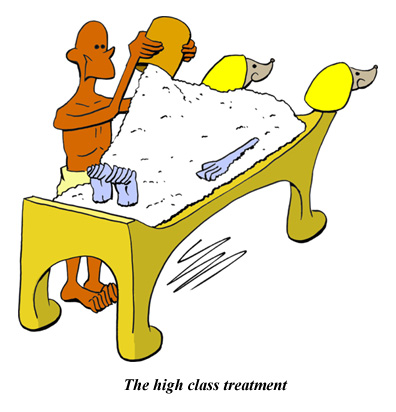
Herodotus said there was a price range for the embalming service. That's pretty much like today. The high class treatment (and most expensive) was the natron method as it was pretty involved. Before the drying, the internal organs had to be removed and the body packed with various kinds of stuffing. Bags of natron, linen, and sawdust all worked nicely, thank you. But in a pinch the embalmers would throw in almost anything. Inside modern mummies you can find, mice, animal bones, and even parts of other mummies that shouldn't even be there.
The big trick was getting the brain out. Again Herodotus told us the brain was removed through the nose, but it wasn't until relatively recently that people did tests on dead sheep (and later on a [dead] person) and found that's pretty tough to do. What you have to do is stir the brain up so much it liquefies and then just let the goo run out.
For the less well-to-do, there
was an alternative and more economical procedure - again according to
Herodotus - that didn't involve making a hole into the head. Instead
the embalmers concentrated their efforts at the other end. A
corrosive liquid was - shall we say - "supposited" into the lower
abdomen. That's the low abdomen. The very low abdomen.
Then the aperture was corked up for a bit. This pretty much dissolved
everything internal. Upon pulling the plug, so to speak, the body
flushed itself out ( no joke intended). There was an even cheaper
option, but it involved the same basic technique. Once more this is
all according to
Herodotus.
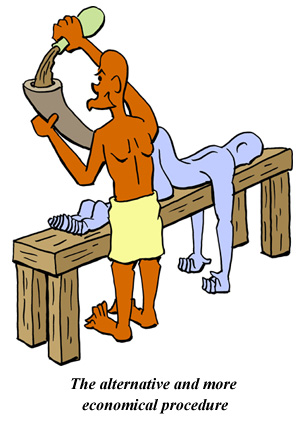 In any case, you can
understand why embalming was not done indoors, but rather in tents,
preferably up on top of a well ventilated hilltop.
In any case, you can
understand why embalming was not done indoors, but rather in tents,
preferably up on top of a well ventilated hilltop.
Whatever the method, when everything was done but not said, the mummy was wrapped. At this point there were also all sorts of religious hooplah particularly if you went for the expensive option. In fact, it took another thirty five days after the actual mummification for the rituals to be completed which adds up nicely to the seventy days of mourning for Joseph's dad, Israel, in the Bible, and the seventy days mentioned in Herodotus. Then when everything was done and said, the body given back to the family.
Contrary to what some people think, almost none of the mummies of the pharaohs were found in their own tombs. The body of Amenhotep II was found in its sarcophagus although it's possible that mummy is not really Amenhotep. In fact, a lot of the mummies touted as being this or that pharaoh may be (and in some cases certainly are) someone else. The only pharaonic mummy which was indisputably found in its original resting place (nice phrase) was that of Tutankhamun. Tut's mummy, by the way, is in sad shape. It was brittle to begin with and the fact that the archeologists had to chop it up to remove it from the coffin didn't help at all.
That Old Time Religion
The religion is what a lot of
people see as the strangest thing about the Ancient Egyptians. After
all, these people worshipped a multitude of weird gods with animal
heads, they thought cats were sacred, and that their king was a
god.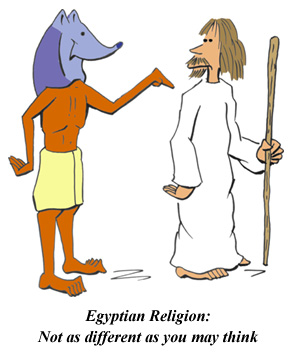
Well, for one thing not all the Egyptian gods had animal heads. They didn't worship cats, and as in all countries, a lot of the people probably thought their leader was a dunderhead. So it shouldn't be a surprise that compared to our own, Egyptian religion wasn't as different as you might think.
True, at first glance, the mythologies also aren't something you'd think about teaching kids in first grade Sunday school. One of the stories of creation has the god, Atum, sitting around by himself. But not having a willing lady god to address his need (to paraphrase a character from one of the more famous Russ Meyer movies), what could he do but - ah - take the matter in hand. The outpouring of his efforts fell to the ground and from these offerings sprang forth the other gods. Now just try putting that story of creation on the ceiling of the Sistine Chapel.
What is remarkable is that a group of local creeds scattered up and down the length of the Nile somehow coagulated into what was a fairly unified religion with beliefs that foreshadowed our own. For one thing Egyptians were the first people to be clear cut resurrectionists and preach about having a good afterlife. They stressed it was important to do good on earth and that those found wanting would be thrown into the nethermost pit. Put all that with another of their creation stories where the world was originally formless chaos and the primordial God (Atum again) brought forth the land from the water, and it ought to start sounding pretty familiar.
But except for the time of the relatively brief Atenist heresy (when the Pharaoh Akhenaten banned polytheistic worship for his favorite god, the disk of the sun), each town or region still had its own particular god. There was Ptah in Memphis; Set in the Delta, Amun in Thebes, that sort of thing. It wasn't until later years (after Rome fell) that people decided if you conquered someone with a different religion you should make them convert. But having different people worship differently did never seemed to bother the Pharaohs.
One thing that helped smooth things over was that Egyptians had a philosophy that allowed them to think of having a whole regiment of gods as monotheism. Despite all the hooplah about "the thousand gods of Egypt", "the thousand gods of Hatti", or the "thousand gods of Babylon", a favorite interpretation was that there was only one god and all the others were his "manifestations". That's why you get the composite god Amun-Ra (or more traditionally, Amun-Re). Originally, though, Amun and Ra had quite distinct mythologies. Ra was one of the oldest gods in Egypt, while Amun was, sort of, a late comer. But still the one-god-many-many manifestations idea kept everyone happy.
What this meant for the daily
life was that even without a constitution with an added amendment
allowing freedom of religion, religious tolerance was the norm. You
could worship who you wanted, when you wanted, and how you wanted.
Pay your taxes, acknowledge the Pharaoh, and you had no
problem.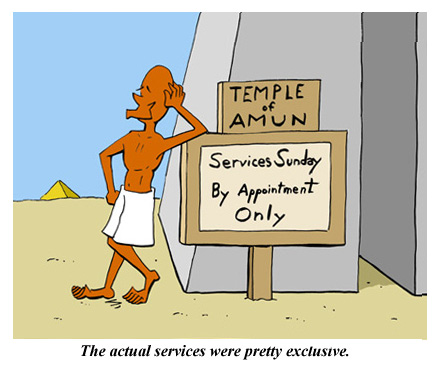
Probably where the Egyptians diverged from us most was the formalized worship was pretty exclusive. Only the priests (and maybe the Pharaoh) were ever allowed into the sanctuary where the god's statue was. The people mostly got to see the god on religious holidays when the priests paraded the statue around town (again as is still done on Saints' days in some European countries) and up and down the Nile. And even then the people had to keep their distance.
The religious leaders - the preachers or priests or what-have-you - also didn't have to be all that sincere or pious either (which, too, is not all that different from today given the more or less recent goings-on). The main thing was they had to know the rituals and carry them out correctly. From offerings, contributions, and patronage from the well-to-do, the religious leaders eventually got to be among the richest people in the world (again not so different from today). Eventually the temples had so much wealth and owned so much land that the priests rivaled the power of the Pharaoh. In the later years, the high priests of Amun even became Pharaohs. But by that time, Egypt was no longer the most powerful country in the world.
Daily Life in (Modern) Egypt
The last native Egyptian Pharaoh was Nectanebo II, who was driven out of the country by the Persians in 343 BC. The Persians ruled until Alexander the Great put the Greeks (Macedonians, actually) in charge and that lasted until Cleopatra backed Mark Antony. Mark was the wrong Roman, and he and Cleo were defeated by Augustus at Actium. So in 30 BC Egypt became a Roman, and eventually a Byzantine province.
Then along came the Arabs
around 640 AD, and they transformed Egypt permanently into an Islamic
country with an essentially Arabic culture. But soon the native Arabs
were booted out to be replace by the Mamelukes under the Kurd,
Saladin (the same Saladin who fought Richard the Lionhearted). The
Mamelukes themselves were conquered in the early sixteenth century by
the Turks, and so Egypt became a province of the Ottoman Empire.
That's the way things were as the Eighteenth Century began to wind
down.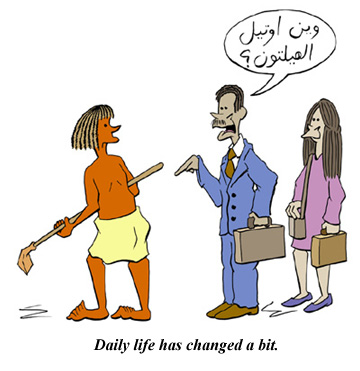
In 1798, Napoleon Bonaparte, then a young general working for the Revolutionary French Government, told his bosses their idea to invade Britain was crazy. Instead, he said, they should invade Egypt which was Britain's route to the Red Sea. Fine, the Government said, and Napoleon headed toward Egypt. Amidst fighting a couple of battles and watching his soldiers die of thirst, he had brought along a contingent of scholars and scientists to study Egypt. Eventually everything they learned was put together in a massive multi-volume book, Description de l'Egypte, which was the real beginning of Egyptology. The book had the first accurate representation of Egyptian monuments and the hieroglyphics were copied so accurately that Egyptologists can read them today. The French also discovered the Rosetta Stone but because the English won the war, it ultimately went to the British Museum.
Napoleon was finally defeated by Admiral Horatio Nelson at the Battle of Abukir Bay, usually (and incorrectly) called the Battle of the Nile. Horatio sailed away and Nappy returned to France.
There was in effect no one ruling Egypt and so the Ottoman Sultan (who always had considered the land part of his empire) sent a young Greek (Albanian actually) officer Muhammad Ali Pasha to fix things up. Although nominally under the Ottoman's rule, Muhammad was for all practical purposes an independent ruler. He died in 1849 but his family kept ruling, strictly speaking, until 1952.
Strictly speaking, "strictly speaking" means the British and French were really in charge. In the 1850's the French had decided they wanted a canal to connect the Mediterranean and Red Seas and so leased a strip of land in the Suez for ninety-nine years. It took them over a decade to build the canal, but finally on November 17, 1869, ships began rolling through. By various machinations the British ended up with a good chunk of stock in the company although officially the French were running things. Nominally, though, Egypt was not under French or British rule.
By the late 1870's, the country was almost bankrupt. It was literally the old saw that while the peasants were starving and the king (and British and French) were living in splendor. So when it looked like there might be a military revolt to boot out the Europeans, the British sent in troops to "protect" the canal. That was in 1882. However, the Ottomans still ruled all of what was called Syria-Palestine which is modern Israel, Jordan, Lebanon, and Syria. They were also still in charge of Arabia and of course Turkey.
Then the Turks really blew it by siding with Germany in World War I. When they lost the war, the rest of their empire passed to the British and French. The French got Lebanon and Syria and the British got Palestine and kept Egypt.
The British liked to think of themselves as helping small nations be free and so in 1922 granted Egypt - quote - "independence" - unquote. Figuring if the Egyptians had liked Pharaohs for 3000 years, then the modern residents would be happy with a constitutional monarchy. So they set up Faud I as king with a parliament, prime minister, and all the trimmings. But John Bull still kept a hand in running the country. So if the native Egyptians got too frisky and elected someone they didn't like, England would send in the troops and make sure the next prime minister was someone they did like.
When Faud died in 1936, his son, Farouk, a big, fat, feckless slob, became king. Farouk was one of the biggest jerks every to occupy a throne in Egypt or anywhere else for that matter. He lived well - too well according to people who thought that some, just some of the money used to perpetuate Farouk's lavish banquets and palaces might have a better use. Then in 1952 a group of army officers (among them a young colonel named Gamaal Nassar) tossed Farouk out. Showing a magnanimity not always present after a coup d'etat, the new leaders let Farouk live but made him leave the country.
In 1956, Nassar nationalized
the Suez canal and the brief war between Egypt, England, and Israel
ended up with Egypt finally and really being independent. Farouk
himself died in lavish exile in Monaco in 1965, the last of the
Pharaohs, if you want to call him that.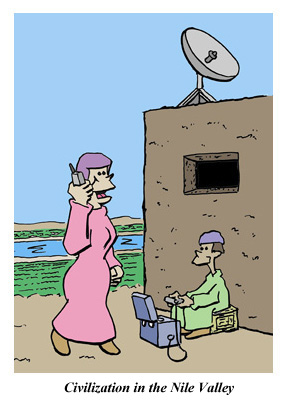
Daily life in Egypt has changed a bit. Sure, you can take a cruise down the Nile and see farmers still plowing the land with oxen, irrigating their fields using the shaduf, and their wives baking bread in outdoor ovens. But you can also see cell phones, video games, and satellite dishes. In Cairo there are night clubs, traffic jams, pollution, and overcrowding. But who knows? One day civilization might once more return to the Nile Valley.
References
"The Persian Wars", Herodotus, Volume 1, Loeb Classic Library, Harvard University Press, 1990. Many editions of Herodotus are available (including electronic editions on the internet) but the Loeb library editions are about as definitive as you can get and have the Greek facing the English translation. Book II (in Volume 1 of the Loeb edition) has the history of Egypt.
"The Oxford Encyclopedia of Ancient Egypt", Donald Redford (Editor), Oxford University Press (2000). Forget about buying this since you'll have to shuck out anywhere from $500 to $700 for all three volumes. And watch it. Some people have said some sellers make it sound like they'll give you all three volumes for $500 and only send you one.
But if you live in a large city with a good library system you might find a copy in the reference section. Unfortunately a quick look through it makes you doubt the price is worth it. Some of what you'd think should be major topics only have a couple of pages. The truth is you can often find more in depth information just by digging on the internet and in far less expensive books.
Why is it so expensive? Who knows? Maybe there was some airheaded MBA who did a cost analysis figuring only eggheads would buy the books. So to recoup their cost and make their margin, they figured $500 would cover it. Not realizing, of course, that there are plenty of nonscholars who would gladly shuck out $30 to $50 a book that would more than add enough volume to make OUP a nice bit of change.
Some topics:
"Beer,"Delwyn Samuel, Vol. 1, pp. 171 - 172
"Bread,"Delwyn Samuel, Vol. 1, pp. 196-198
"Taxation, "Sally Kadary, Vol. 1, pp. 351-356
"Red Land, Black Land: Daily Life in Ancient Egypt", Barbara Mertz, Dodd Mead, 1978 (Original Edition, Coward McAnn 1966). A popular account, but naturally it doesn't include the most up-to-date stuff. But frankly, in Egyptology a lot of up-to-date stuff sometimes seems to be recycling of old theories people think they've just come up with.
Barbara has an entertaining style of writing and has no hesitation in pointing out how completely tenuous some of the accepted "facts" of history are. Egyptian history, in particular, has a lot of well accepted findings which most writings agree on. But if you dig in the actual sources and journal articles you'll be surprised that many of these Great Truths are really just guesses.
"Temples, Tombs, and Hieroglyphs: A Popular History of Ancient Egypt", Barbara Mertz, Dodd, Mead (1978). Barbara's classic account of the history Egyptology rather than Egypt per se. But also a lot about non-Egyptian archeology.
"Ancient Egypt", Lionel Casson, Great Ages of Man Time-Life Books, (1965). This book was from the era when Time-Life books were fantastic introductions to a number of topics. This is one of their better books and the only drawback is it's short and general. So you can learn more only by going to more in depth works. But that's, we suppose, the whole point of a introductory book.
In addition to being a regular academic historian, Lionel writes some of the best of the popular histories. In his nineties at the time of this writing, Lionel is still going strong and listed on the faculty of New York University.
Time-Life, on the other hand, is still in business, but their more recent series range from the OK to the absurd. In particular Time Life has fallen to putting out series like their "Mysteries of the Unknown" which simply pander to the increasingly superstitious nature of our so-called modern society.
"Everyday Life in Ancient Egypt", Lionel Casson, John Hopkins University Press. A bit more in-depth than the Time-Life book but there's a lot of overlap (often word-for-word).
"The Manners and Customs of the Ancient Egyptians", John Gardner Wilkinson, 3 Volumes, John Murray (1837) and later editions. By "manners" Gardner doesn't mean whether Egyptians smacked the lips or chewed with their mouths open. Instead, this was really the first (and massive) "Daily Life in Ancient Egypt" books. The three volumes aren't readily available but you can (legally) download electronic copies of later revisions. As in all old books, you have to be careful not to be taken in by the older (and discarded) ideas. Definitely worth looking at if nothing more than for the line drawings of paintings and reliefs, many of which are now damaged or lost.
"Life in Ancient Egypt", Adolf Erman, Dover Publications (1972). Not so massive as Gardner's books, it shares the virtues and vices of the more massive tome. But this is regularly and more cheaply available.
"Sexual Life in Ancient Egypt", Lise Manniche, Kegan Paul (1987). A quite expensive but slim volume which may disappoint the reader who's fishing for explicit prurient material. The Egyptians didn't seem to have the obsession we do about making whoopee. They just did it and didn't bother devoting an entire literature and entertainment industry to it.
"Archaeology of Ancient Egyptian Beer", Delwen Samuel, Journal of the American Society of Brewing Chemists, Vol. 54, pp. 3-12 (1996). This is a technical paper full of the cautions and warnings that should always be present in a properly written scientific article (sadly missing, though, in a lot of so-called educational television programs). You also need to have a basic understanding of the brewing process and the botany of grain to follow what's being said. The conclusions is the Egyptians made beer a lot like we do.
A copy of the print article is on Delwen's website listed below.
"Women in Ancient Egypt", Gay Robins, Harvard University Press, 1993. A book on (obviously) women in Ancient Egypt. The trouble is there's a heck of a lot more we don't know about Egypt than we do and like the book by Lise on making whoopee you come away wishing we knew more.
"Slavery in Ancient Egypt and Mesopotamia", Jacqueline Greene, Franklin Watts (2000). Few books deal with slavery in Egypt. This book is for kids and seems to stick with the traditional picture that Egyptian slavery was pretty much like that in Greece and Rome and that slaves worked on the pyramids. The latter point is not correct and the builders were paid laborers. That there were people we would call slaves in Egypt is true, but at that point in history it's questionable that full of chattel slavery had yet come into being - at least in Egypt.
"Ancient Egypt: Discovering Its Splendors", National Geographic Society, 1978. A book by multiple authors, and there might be a tendency to dismiss this as a "coffee table book". But it has great illustrations and discusses life in Ancient Egypt in some depth. The book was even published with a sample of real papyrus on one of it's pages.
"Egyptian Mummies: Unraveling the Secrets of an Ancient Art", Bob Brier, William Morrow and Company (1994). A popular account of how mummies were made by a man who actually mummified someone.
"Egyptian Mummies", G. Elliot Smith and Warren Dawson, Paul International Ltd., (1991). A reprint of one of the first mummy books (1924). Elliot Smith was an anatomist who can be considered one of the first pioneers in serious mummy research. The book is a bit out of date in light of modern thinking. He talks about putting mummies in a natron solution (we now think they covered them with dry nation) and they took the brain through the nose with hooks (actually they rammed a metal rod through the nose and liquefied the brain by vigorous stirring and let it run out).
This is also the book that has what has might be called Elliot's Big Blooper. He says the mummy of Amenhotep III of the 18th Dynasty was mummified using a special technique where packing was placed under the skin to give it a more lifelike appearance. The technique, he says, was abandoned and not reinstated until the 21st Dynasty, a couple of hundred years later. Of course, Elliot missed the whole point. The proper conclusions is the mummy is not that of Amenhotep III and is a mummy from the 21st Dynasty.
There are some Egyptologists, though, that say the situation isn't so clear cut. Bob Brier in his book (see above) says that the packing of Amenhotep III was with resin, not with the stuff from the XXI Dynasty which was a "cheesy" mixture of fat and soda (sodium carbonate). He also says the cheesy stuff was used to pack the mummy of Ramses III in the XIX Dynasty. But it's not clear if he meant Ramses III "packing" done under the skin or in the body cavity. The crucial question is which was the first mummy - aside from "Amenhotep III" - to have the packing specifically under the skin to give the lifelike appearance.
One thing to remember is the Amenhotep III assignment - along with the naming of most of the royal mummies - is shaky no matter what. The coffin was originally intended for Seti II and Amenhotep's name does not appear anywhere. There is only the "throne name", Neb-Maat-Ra, which was also used by Ramses VI. Egyptologist and businessman Frederick Giles thinks the priests thought they were reburying Ramses, and even then they were probably wrong!
"Who Was Who Among the Royal Mummies", by Edward F. Wente, The Oriental Institute News, No. 144, 1995, http://oi.uchicago.edu/research/pubs/nn/win95_wente.html, for more on the confused state of Egyptian mummies.
Superb article about the problems with identifying the mummies. What is really interesting is the possibility that we may have Akenaten's mummy after all - but it's the one people usually say is Amenhotep III! (If that's the case, then Professor Bob Brier is correct about how it's stuffed). The assignment is just a possibility, of course, but if you look at the jaw line of the X-ray of the skull of "Amenhotep III" it has the long drooping line that is characteristic of Akenaten's statues. The problem though, is the back of the skull is not elongated - not even as much as Tut's - so the assignment is by no means definite.
"Middle Egyptian: An Introduction to the Language and Culture of Hieroglyphs", James P. Allen Cambridge University Press, 2000. Copies can be expensive but probably the best introduction to Ancient Egyptian. But be warned! This is a real textbook, not just a "have fun with hieroglyphics" type book. Also the type is pretty small so it doesn't make it the easiest book to read from.
"Grammar Of The Coptic Language With Easy Reading Lessons", George F. Black, British American Books, 1996. A simple introduction to Coptic.
"The Last Pharaoh: Farouk of Egypt", Hugh McLeave, McCall Publishing Company (1970). No doubt about it, Farouk, was a jerk. In his younger days he wasn't quite the big, fat, slob, he later became, but as his photographs show, he was a pudgy, oily, smirking, irresponsible jerk.
"Early Islam", Desmond Stewart, Great Ages of Man Series, Time Life Books 1967. Some background on (what else?) early Islam including a little of when Egypt fell to the Arabs. It also mentions Muhammad drinking nabith. See also "Lucozade and Ribena 'Fit for Muslims to Consume', Vikram Dodd, Guardian Unlimited, Monday, August 2, 2004. This tells how nabith is still used as the Islamic benchmark for defining forbidden alcoholic beverages.
Desmond Stewart, by the way, was a well known British authority on the Muslim world and has the distinction of writing the absolutely worst book ever on T. E. Lawrence. It is filled with completely unsupported assertions, horse hockey, and poppycock. Stewart, by the way, also seemed to have difficulty in separating truth from fiction even in his private life. In 1981 he became convinced people were out to get him and died in Cairo.
Web Resources
As oft stated in the Merry Histories, the internet can be unstable, unreliable, misleading, and with the increase in sponsored links, intrusive (and irrelevant) ads increasingly difficult to use. Despite what is often claimed, targeted text based ads can be just as irritating and irrelevant to a search as animated and flashing ads.
That said, many sites on Ancient Egypt are largely factual, historical, and well designed. Some include primary source material or are articles referencing credible historical sources. Some of the better and more informative ones are:
"Description de L'Egypte" at http://descegy.bibalex.org/
An online version of the massive reference work that came from Napoleon's expedition. with both the text and plate volumes. The main drawback is the irritating animation as the pages load and some of the displays. Please, web designers, unless the animation is needed a web page should be treated as text to be read and images to be viewed.
"Ancient Egyptian Society and Family Life", Douglas J. Brewer and Emily Teeter at http://www.fathom.com/course/21701778/sessions.html
A nice but fairly brief summary of daily life with a focus on the family.
Mankato State Museum, http://www.mnsu.edu/emuseum/
The MSM has an excellent web site on Egypt. This includes a lot about the day to day living at http://www.mnsu.edu/emuseum/prehistory/egypt/dailylife/dailylife.html
"Ancient Egypt: An Introduction to the History and Culture of Pharaonic Egypt", http://www.reshafim.org.il/ad/egypt/
An excellent site from Kibbutz Reshafim in Israel. Lots of information which goes into a bit more depth than usual. There are also a lot of translations of papyri and inscriptions. Excellent information for the beginner and informed alike.
Oddly one of the pages of this site came up at http://nefertiti.iwebland.com/people/index.html#rem2. However, this latter URL has an extremely annoying pop-up that fills the screen every time you move to another page.
"Ancient Grains", Grain was literally the staff of life in the ancient world and no less so in Egypt than elsewhere. A lot of research papers by Delwen Samuel, professor of biochemistry at Cambridge are at http://www.ancientgrains.org/html/delwen_s_papers.html
"Tour Egypt" http://www.touregypt.net/ A nice site with some good articles complete with references. You do, in fact, learn more about Egypt here than in many of the textbooks. Some good sections to read are:
"Slaves and Slavery in Ancient Egypt", Jimmy Dunn, http://www.touregypt.net/featurestories/slaves.htm
"Ancient Egypt Sexuality", Caroline Seawright, http://www.touregypt.net/featurestories/sexuality.htm
"Ancient Egyptian Alcohol", "Caroline Seawright, http://www.touregypt.net/magazine/mag04012001/magf2.htm
"Party Time in Ancient Egypt", Ilene Springer, http://www.touregypt.net/featurestories/partytime.htm
One drawback is their search engine seems to be generic and so doesn't seem to work that great.
"History of Egypt", Wikipedia, http://en.wikipedia.org/wiki/History_of_egypt. Without doubt one of the best designed websites regarding efficiency and usability (with some lamentable lapses), Wikipedia is extremely helpful for quickly finding the general information about a subject and getting dates and timing of historical events. Despite what most people may claim, almost everyone checks with Wikipedia. Recently - and this was related first hand by one of the participants - the physicians at a major metropolitan hospital were a bit stumped by some symptoms related to them by a patients. The first place they checked was Wikipedia
That said, despite the ease of use and a sincere desire of the creators to provide accurate and in depth information, nothing - that's nothing - in a Wikipedia article should ever be accepted as factual without checking in another independent and credible source. The major problem is that anyone can put anything in a Wikipedia article. True, Wikipedia will sometimes put up a warning flag of some kind, but rarely remove the questionable or incorrect information. You could read in the Wikipedia article about Al Capone that Al thought he was haunted by the ghost of one of the victims of the St. Valentine Day's Massacre and the officials on Alcatraz called in a paranormal investigator. There is no credible source for this story at all, and it is simply an urban internet legend. (Fortunately, at least for now, this misinformation has been removed.)
So in Wikipedia you can find accurate information and superstitious claptrap side by side as if the latter were as credible as the former. Nevertheless, most of the Wikipedia articles on Egypt and its history appear accurate, detailed, and comprehensive. For a quick review of Egypt from the earliest times to the present, Wikipedia is a good source, and thankfully, the superstitious Egyptians-needed-aliens-to-do-anything point of view has been kept out, at least at this writing.
But a good example of a Wikipedia article on Egypt to be wary of is the one about King Tut. At the time of this writing, Tut's article states as if it were well accepted by historians that he died from a severe knee injury. This theory comes out of CAT scans done on Tut's mummy in 2005. But if you read the full articles on the CAT scan work, you'll find that opinion was divided on whether the so-called knee injury was pre- or post-mortem. There was, for instance, no hematoma or clotting present, which would have been present if the injury occurred while Tut was alive. Another argument for the injury being pre-mortem was the kneecap was missing, as was reported in a television show on the CAT scan work. But the 1925 report said the kneecap was not missing but simply loose and could be lifted out. The real truth is during the CAT scan tests, the researchers found the knee cap was simply wrapped with Tut's hand - a fact conveniently omitted in the television show. What happened, of course, was the one of the teams that examined Tut in 1968 wrapped it with the hand.
But the greatest argument against the "Tut-broke-his-knee" theory is that Douglas Derry, the anatomist who carried out the autopsy in 1925, saw no fracture. What he wrote was - and we quote - "The lower end of the femur came away at the epiphysial line, showing the cartilaginous surface intact, there being no sign of any commencing union between it and the shaft of the bone." He saw an unfused bone - typical of teenagers - not a broken leg. Not surprisingly the "broken" bone of Tut is exactly where the bones fuse.
What happened was Tut's mummy was cut and broken apart when it was taken out of the case. There are photographs taken in 1925 and show the arms, feet, and hands separated from the body. They even cut off Tut's head, for crying out loud, and there's photos of it sitting on a table. But no one seriously thinks these breaks were due to Tut having such a bad accident that his body broke apart. They're from the original archeologists cutting the poor fellow up.
Yes, it's been said the knee break is "different" and "rougher" than the others. Well maybe. But Tut's mummy has been handled so roughly over the years (starting from when it was cut apart by the original archeologists) and it's so fragile (bone flakes away with the skin), that every time Tut's examined he falls apart a bit more. Before long we'll think of Tut as the vanishing man. Truth to tell it's hard to see how the cause of Tut's death can ever be determined. Certainly we need a more evidence to believe what we're seeing at the knee is a real injury. A lot more. But you won't learn any of this in the Wiki article. No, you have to actually (gasp!) read books!
Sad to say selective and incomplete reporting of information to get a sensational story is all too common today, even in modern educational articles and television. Don Herbert, where are you now that we need you?
Remember: If it's on the internet, check the sources out first - and that includes what you read in the Merry Histories!
Return to Tutankhamun's Archeologists Caricatures
Return to Herbert Winlock Caricature